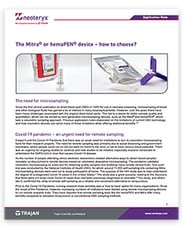DBS Microsampling with Precision
Dried blood spot (DBS) microsamples have been used for decades, but DBS sample quality can be unreliable, due to sampling technique and hematocrit effects. The hemaPEN® device was designed to overcome these limitations and simultaneously deliver 4 reliable DBS microsamples with ease & precision.
An Alternative to DBS and Phlebotomy
Those working in preclinical studies, pharmacokinetics, drug monitoring in pharmaceutical clinical trials, toxicology and serology studies rely on precise, quantitative blood samples to generate reliable data. Volumetric microsampling devices provide quantitative precision and ease of use for both professionals and laypeople as an alternative to DBS and traditional blood draws.
Explore resources on using the hemaPEN® for next-generation DBS microsampling to advance science and medicine.
Frequently Asked Questions (FAQs)
Yes, our microsampling technologies have been used in many research studies, clinical trials and therapeutic drug monitoring (TDM) programs around the world. Our Technical Resource Library includes a searchable selection of published literature discussing studies and trials that applied remote specimen collection and volumetric microsampling. Type your analyte of interest in the library's search field to find journal articles, presentations and application notes from third-party experts.
Many analytes can be extracted using our volumetric microsampling technologies, such as the hemaPEN® and Mitra® devices with VAMS®. These technologies have been demonstrated to be compatible with testing schema in published studies. Some of the literature and resources on our website discuss the different analytes that have been extracted using our microsampling devices. Visit our Technical Resource Library and type your analyte of interest in the library's search field to find relevant literature and case examples.
Sample success rates will depend on the type of testing performed in a lab. Published validation studies demonstrate that our microsampling devices have precise volumetric sampling capacities, which have been shown to overcome the HCT that is often observed with DBS. Some studies show that the absorptive VAMS® tips on Mitra devices can absorb homogenous samples with 99% acceptance rates. By following the illustrated instructions and demo videos available with hemaPEN and Mitra, end-users can reliably collect fixed volume samples that are precise enough for lab analysis.
Dried blood sampling continues to expand as laboratories adapt their testing techniques and technological advances allow for greater sensitivity and specificity. Published research papers show that dried capillary whole blood microsamples collected in 10, 20, or 30 µL volumes are enough for good extraction and analysis. These samples also yield high-quality data that are often similar to data from venous blood. The literature provides case examples of microsampling in research applications. Visit the Technical Resource Library to review many comparative studies that describe what others have achieved with microsampling in their research.
The first step in transitioning from other sampling methods to microsampling is an introductory, initial education phase, which may take about 4 weeks. The next steps involve evaluation and validation. The Neoteryx Microsampling Team and Technical Director can provide support through all the steps:
Education: The introductory phase
Evaluation: Extraction, linearity & signal-to-noise studies
Validation: Validating your method
See our Microsampling User Guide for details.
While we are exploring this capability as a future advance in the microsampling industry, traditional wet blood samples and conventional phlebotomy are still used for most standard health panels and the complete blood count (CBC).
 App Note: Precise Volume Samples
App Note: Precise Volume Samples
For end-users who seek microsampling with volumetric precision, the hemaPEN® and Mitra® devices provide various sampling volumes to fit their needs.
The hemaPEN collects 2.74 µL per DBS disk with 4 disks per device. The 4 pre-punched DBS disks can be pooled to produce up to 10.96 µL maximum sample volume per collection event.
The DBS disks are ideal for assays where sensitivity is not an issue, including many LC-MS/MS applications, high sensitivity immunoassay (including certain ELISA applications and PCR applications.
Most DBS applications are compatible with hemaPEN samples because this device integrates industry-standard DBS substrates to minimize method modification.
Download the application note for more details on sampling with the hemaPEN and additional information on sampling with the Mitra devices based on VAMS® technology.
Many organizations have conducted research studies and public health projects using the hemaPEN® for high-precision DBS blood collection, both onsite and out in the field. Read about their work by clicking the button below – blogs on this topic are gathered together in a single, curated list.
Using our hemaPEN® resources and tools, labs can accession and process blood microsamples manually or in high throughput. Learn about the hemaPEN® Opening Tool for safely opening the device to access the 4 DBS samples inside. Consider the hemaPEN®-QC to aid in method development & sample preparation.
Gain Access to the Microsampling Resource Library!
How do others use the hemaPEN device for quantitative DBS microsampling that consistently delivers high-quality samples? For answers, fill out the form to gain access to our Microsampling Resource Library, where you can find materials by typing "hemapen" or your topic of interest in the general search field.


